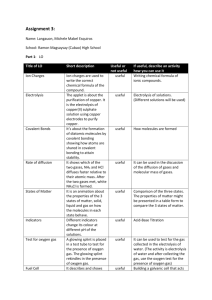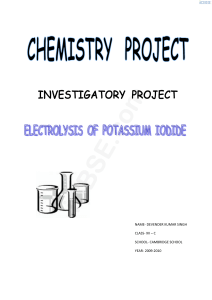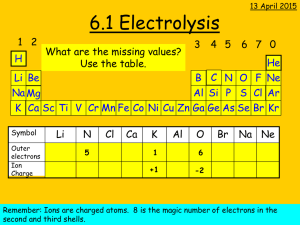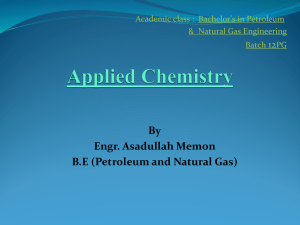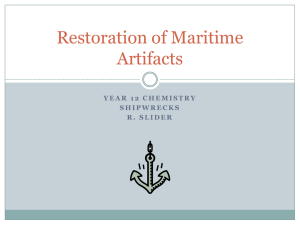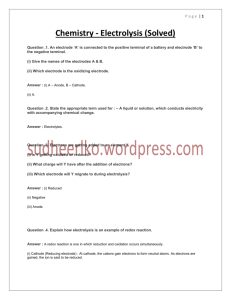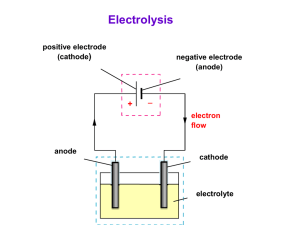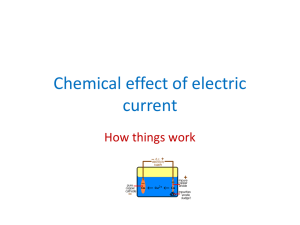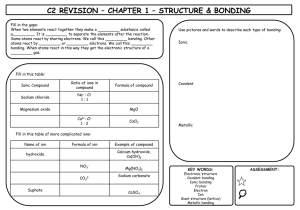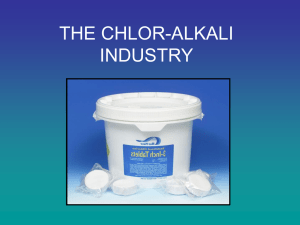Electrolysis of solutions
advertisement
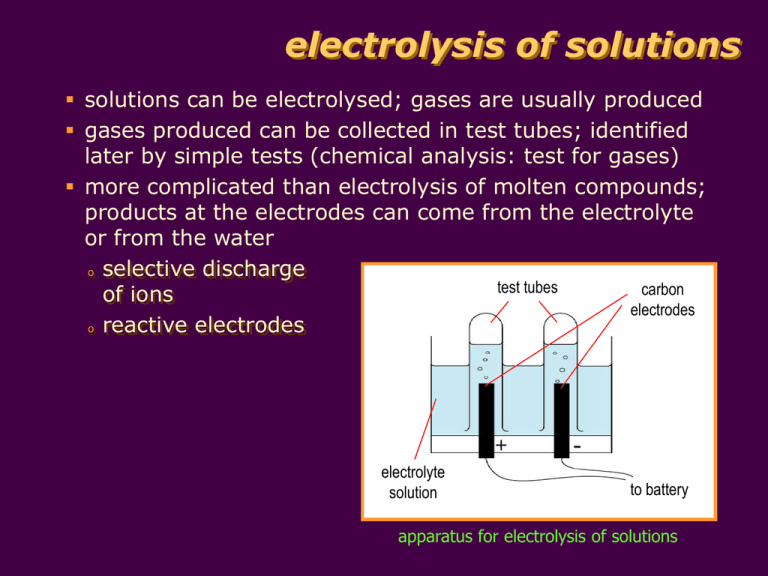
electrolysis of solutions solutions can be electrolysed; gases are usually produced gases produced can be collected in test tubes; identified later by simple tests (chemical analysis: test for gases) more complicated than electrolysis of molten compounds; products at the electrodes can come from the electrolyte or from the water o selective discharge test tubes carbon of ions electrodes o reactive electrodes + electrolyte solution to battery apparatus for electrolysis of solutions electrolysis of solutions selective discharge of ions at the cathode: o positive ions from the electrolyte are discharged if they are H+(aq) ions or ions of less reactive metals such as Cu2+, Pb2+ or Ag+ + + and Ca2+ o positive ions of reactive metals such as Na , K are not discharged in the presence of water; H+ ions from water are discharged and H2 produced at the anode: o negative ions from the electrolyte are discharged if they are halide ions such as Cl-, Br- and I2- and NO - ions are not discharged; OH- ions from o SO4 3 water are discharged and O2 produced electrolysis of solutions selective discharge of ions table shows the electrode products from solutions of ions: Product at Cathode Anion Product at Anode K+ Na+ Ca2+ Mg2+ Al3+ hydrogen from water ClBrI- chlorine bromine iodine Ni2+ Pb2+ Cu2+ Ag+ nickel lead copper silver SO42NO3- oxygen from water Cation reactivity of metal decreases electrolysis of solutions electrolysis of dilute H2SO4 electrolysis of dilute H2SO4: oxygen gas + hydrogen gas - dilute H2SO4 platinum electrodes electrolysis of solutions electrolysis of dilute sulphuric acid dilute sulphuric acid contains H+, SO42- and OH- ions at the cathode, H+ ions take in electrons to become H2 molecules; H+ ions are discharged 2H+(aq) + e- H2(g) at the anode, OH- ions are discharged in preference over SO42-; thus giving off oxygen gas 4OH-(aq) O2(g) + 2H2O(l) + 4e- overall reaction: 2H2O(l) 2H2(g) + O2(g) electrolysis of solutions electrolysis of dilute sulphuric acid examples of electrolysis of different solutions, using inert electrodes Electrolyte Ions in Solution Product at Cathode Product at Anode concentrated aqueous sodium chloride Na+(aq), Cl-(aq) , H+(aq), OH-(aq) from the water hydrogen gas chlorine gas dilute sulphuric acid H+(aq), SO42-(aq), H+(aq), OH-(aq) from the water hydrogen gas oxygen gas aqueous copper(II) sulphate solution Cu2+(aq), SO42-(aq), H+(aq), OH-(aq) from the water copper metal oxygen gas electrolysis of solutions reactive electrodes reactive electrodes can dissolve in electrolyte carbon and platinum are inert electrodes; do not react or dissolve in electrolyte electrolysis of solutions participating electrodes metals such as copper and silver are participating electrodes; they can react or dissolve in the electrolyte copper metal copper(II) sulphate solution Cu2+ copper electrodes are used in electrolysis of CuSO4 solution to refine (purify) copper pure Cu cathode Pure copper from the anode dissolves in the electrolyte giving up its valence electrons to the anode. Pure copper is deposited on the cathode; impurities are left behind. + - + impure Cu anode CuSO4 solution impurities electrolysis of CuSO4 using Cu electrodes
